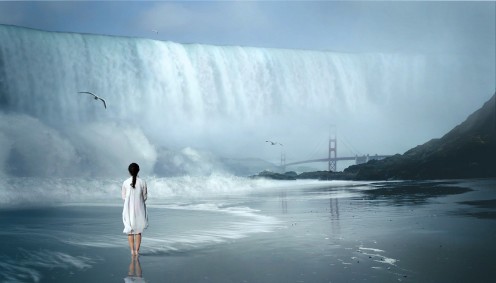What Can I Do If My Home Is Flooded?
Doncaster, South Yorkshire. UK June 2007 - a Sea View You Can Do Without!

Floods Are Becoming More Commonplace. Here's Some Flooding Advice For Home and Business Owners
Severe flooding is becoming more commonplace the world over and thus the climate change implications are an important issue which governments, insurance companies and property owners now need to address more frequently than in the past. Nature is a formidable force that will never be tamed despite the best efforts of government bodies and all concerned.
As Someone Who's Had a property Flooded, the Author Writes From Personal Experience:
As a householder or business owner, when your entire ground floor is underwater up to letterbox level and your inland property has acquired something akin to a sea view, it's difficult to see the funny side. However, you might manage an ironic smile when you realise the sandbags issued to you have proven quite useless. They can hold back a few inches of water but are no good when it comes to severe flooding.
It's no laughing matter and the funny side will only surface once things are back to normal. The only consolation right now is the fact that your property (apart from items of a personal nature) can always be replaced and you have to be grateful for that, however great the loss to property and livelihood. If there is no loss of life or physical injury then you can even say you are fortunate. Property can be reinstated; people cannot. If flooding has also caused loss of life, the impact on you and your family will be more profound and you may need in-depth counselling to help you deal with the trauma so you can reach closure and move on with your life.
When your home is uninhabitable and the majority of the contents destroyed, the time scale for reinstating your home life or business will seem far from realistic so who do you turn to? Don't despair; it may seem insurmountable now but there is hope. Your situation will improve and things will get back to normal.
Something as simple as dry land, a warm blanket, a cup of coffee and a sympathetic smile will suffice initially but as the hours and days unfold, you'll have to deal with the day to day painfully slow progress in getting things back to some semblance of normality.
The insurance company will need to know the whole story as soon as possible after the flooding has occurred and will give you the best advice possible as they will be used to dealing with such cases. A loss adjuster will be appointed to deal with your claim. In the unfortunate position of you not being insured, you'll need to appeal to anyone who you think may be able to help steer you in the direction of official bodies and charities who can offer assistance in any way, shape or form. The importance of insurance for any business owner or householder cannot be emphasised enough and it's 'peace of mind' to have adequate cover against every peril.
The insurance will provide temporary accommodation for all occupants for as long as needed and will guard against loss of business revenue if you're covered. Rest assured, you won't need to worry if the terms of your policy apply.
Access to your flooded property may be denied for safety reasons for a few days but once the flood water is pumped away or subsides naturally, you'll be allowed back to view the damage as long as no structural damage has occurred. You'll likely need to secure the property against looting.
Cleaning up after a flood is not just a case of drying things out. Floodwater can contain any number of harmful substances that need to be dealt with correctly. There may be bacteria from sewage and even rats may have been washed into your dwelling with the floodwater. There will be chemicals from motor oil and pollutants from decaying plant and animal life that were present in river water.
The ground floor of flooded buildings will normally need to be re-plastered because of the cocktail of contamination that has seeped into everything. Be careful with floodwater and everything it's touched; it's not just ordinary water. River water can cause serious health problems if swallowed or if it seeps into open cuts and wounds. Seek medical advice if you're unsure about any flood-related issues that could affect your health.
Flood-damaged furnishings and equipment will all need to be disposed of responsibly. Your property will smell like a cave at low tide once you've swept it clear of mud and associated debris that's entered the building. There will be several buckets of silt to clear away from the ground floor before drying out can begin.
Your appointed loss adjuster will advise you on what to do and what not to do and what things to dispose of etc. but eventually, he'll appoint a surveyor/project manager to oversee the renovation of your property.
Once the flood-damaged ground floor has been stripped of the saturated plaster, drying out needs to be done thoroughly over several months until the shell of the building has dried out enough for replacement fixtures and fittings to be fitted. If your property has a concrete floor rather than a suspended wooden floor you will be at an advantage. All wooden joists will need to be replaced if they have been in contact with water.
The threat of further flooding may force architects to reconsider the typical housing design. Even now, houses on known flood plains have been built on raised banks as a preventative measure. There are however very few measures that can be implemented by the existing property owner to prevent a flood from damaging the building again. Apart from total redesign such as placing the building on stilts so the flood waters can pass beneath it, there's hardly anything that can be done and householders will likely have to pay higher insurance premiums on all previously flooded property. My property insurance is twice the amount it was before.
The Inspiration For Some Great Artwork!

A book About Flooding
Advice From The Environmental Protection Agency
The Environmental Protection Agency offers some sound advice to the general householder in America regarding flood-related issues, as does the Environment Agency to those in the UK.
Could It Be Climate Change?

Drone Footage of UK Flooding
© 2015 Stella Kaye









